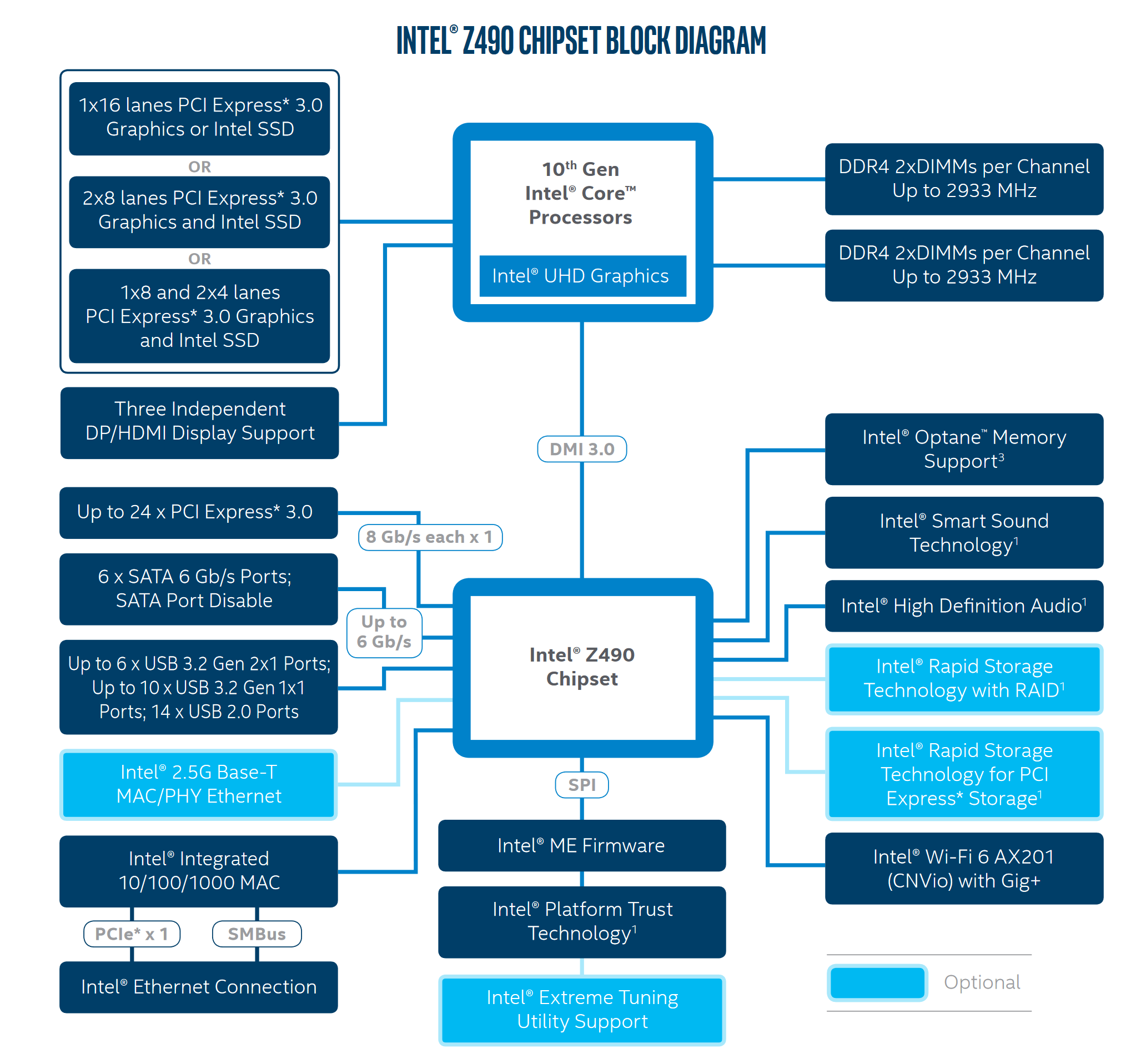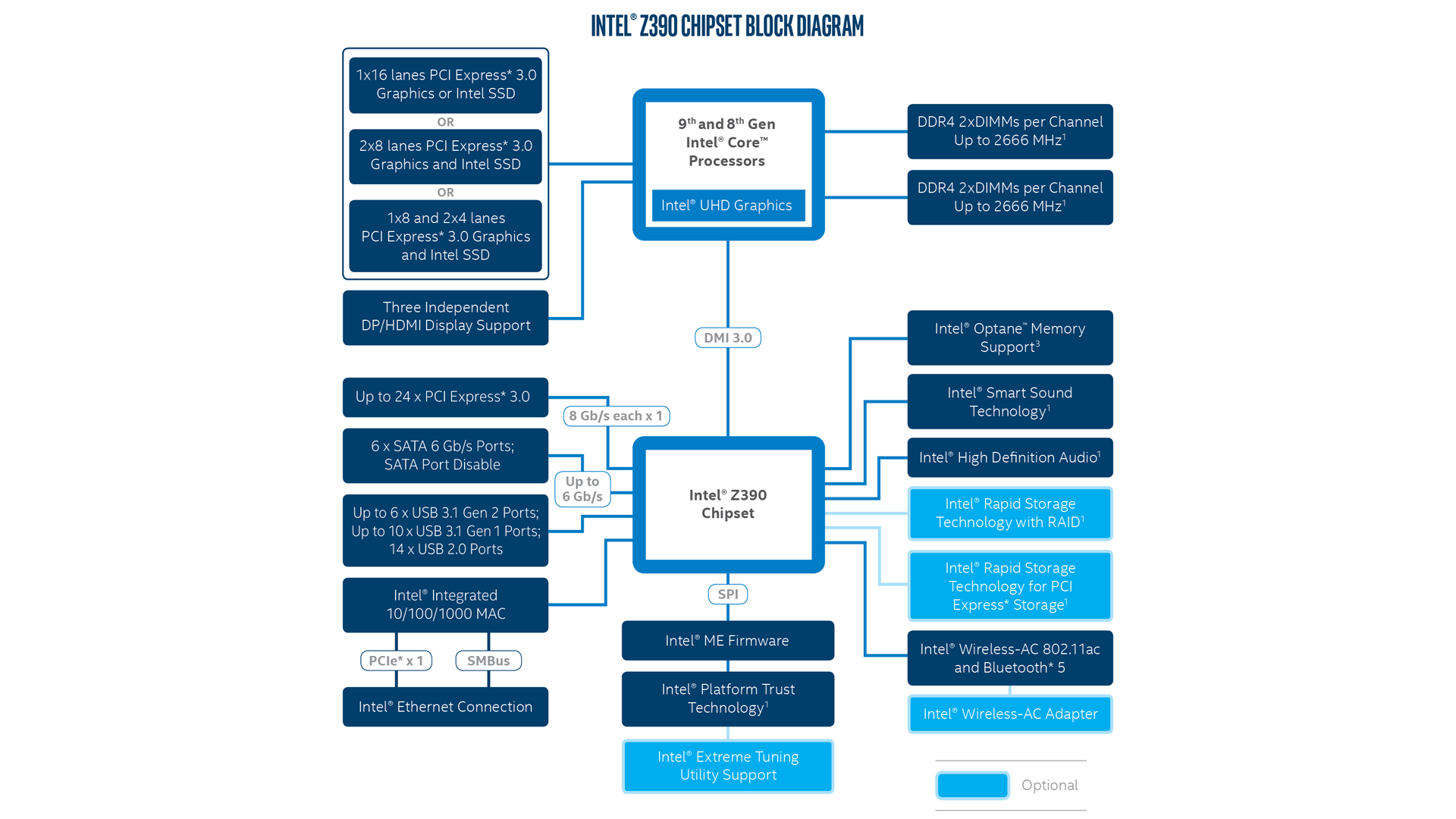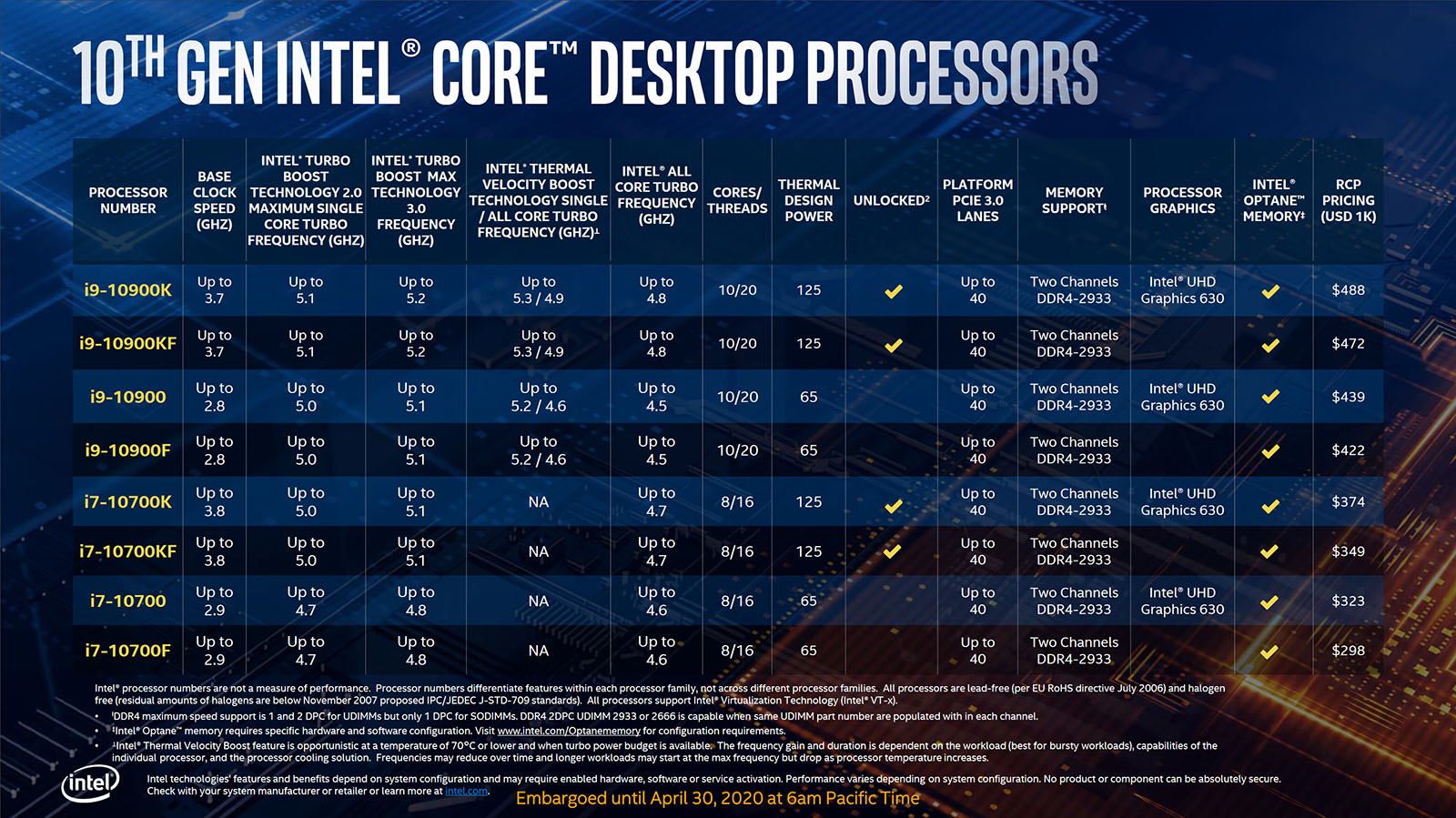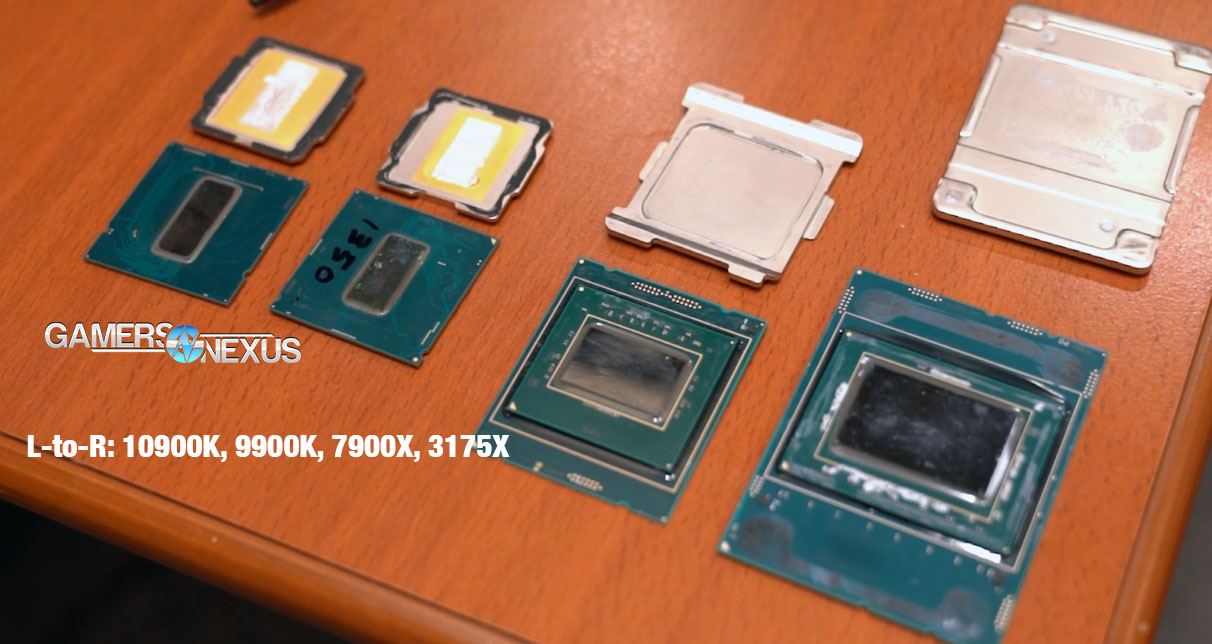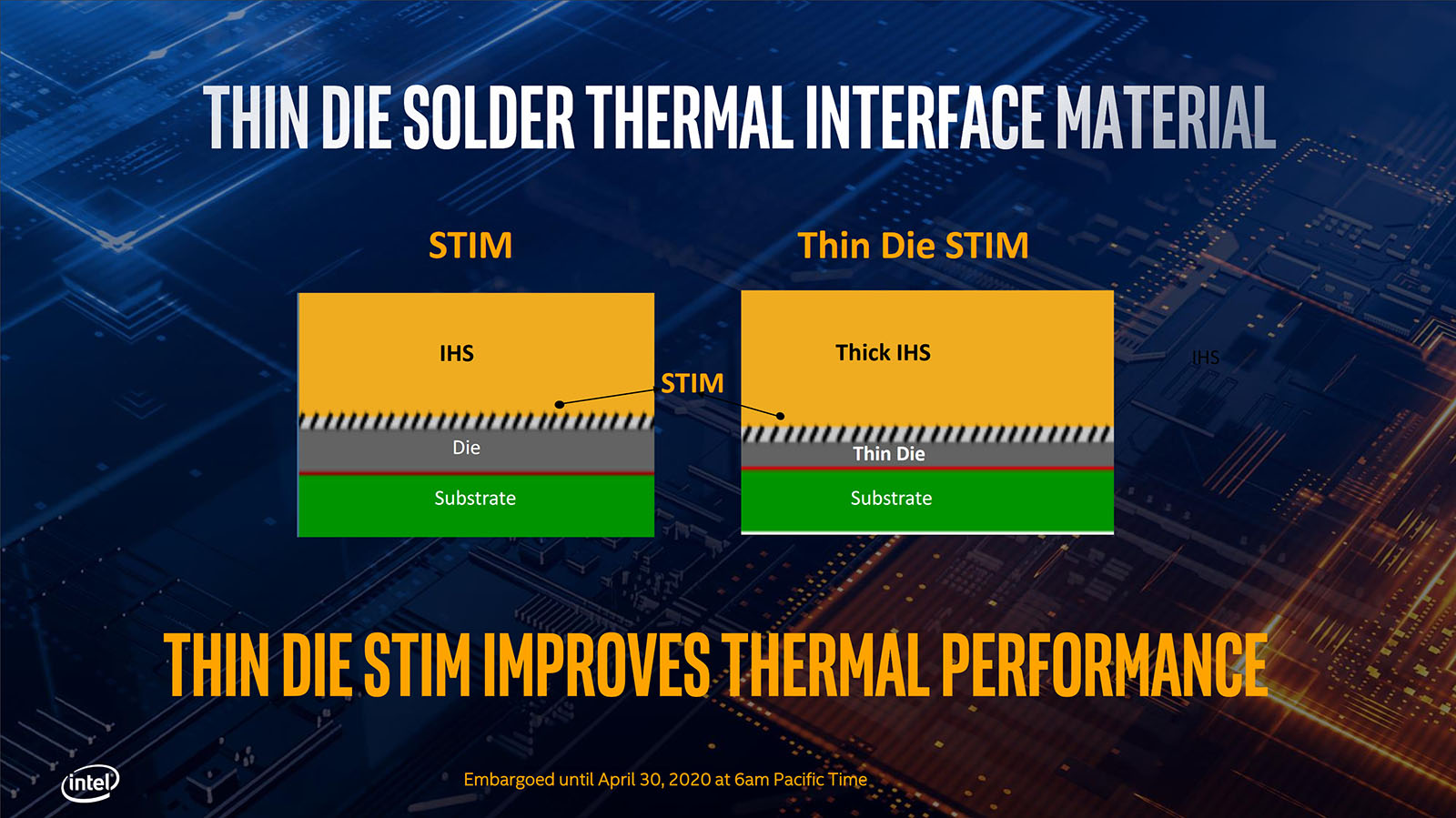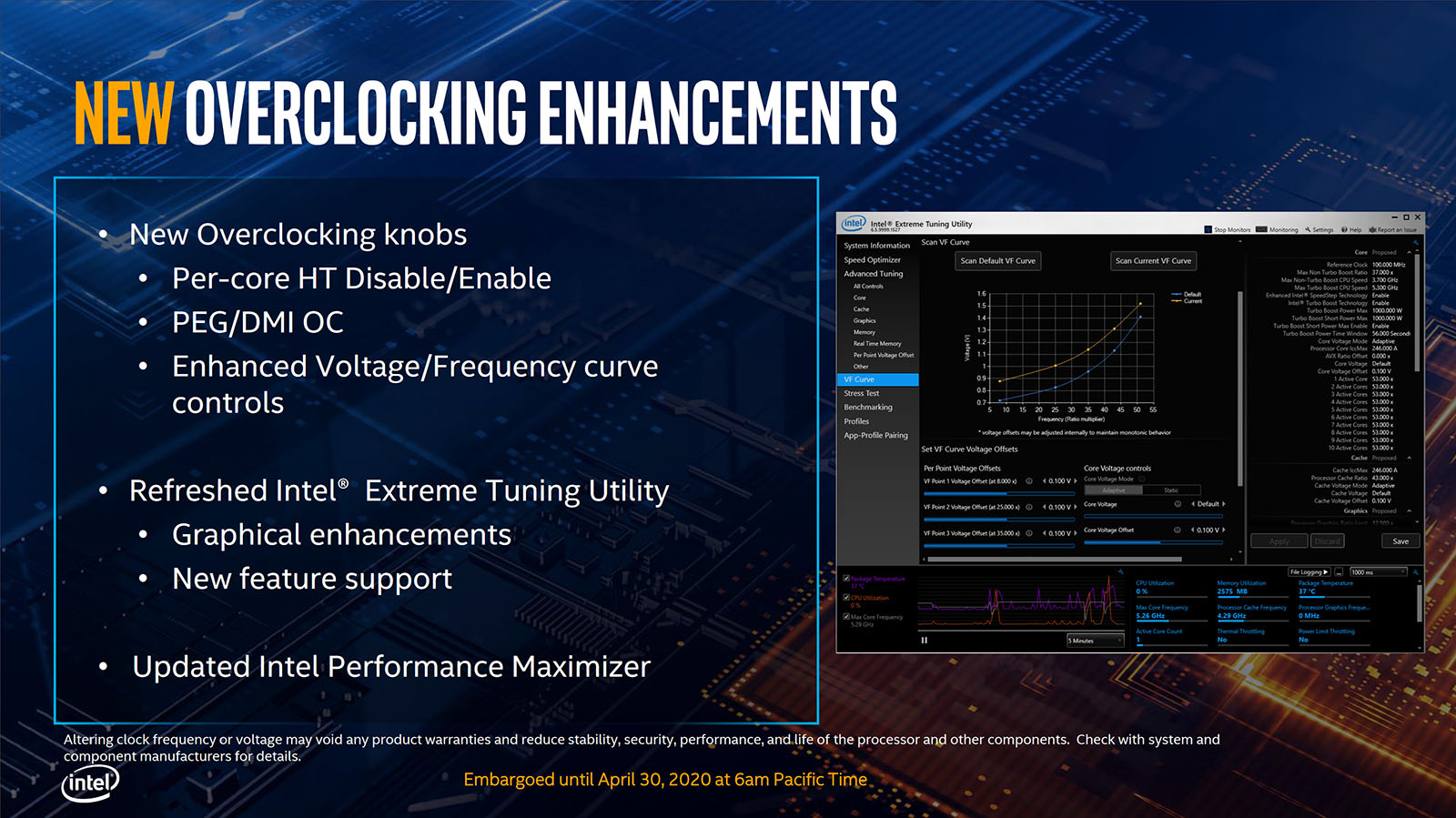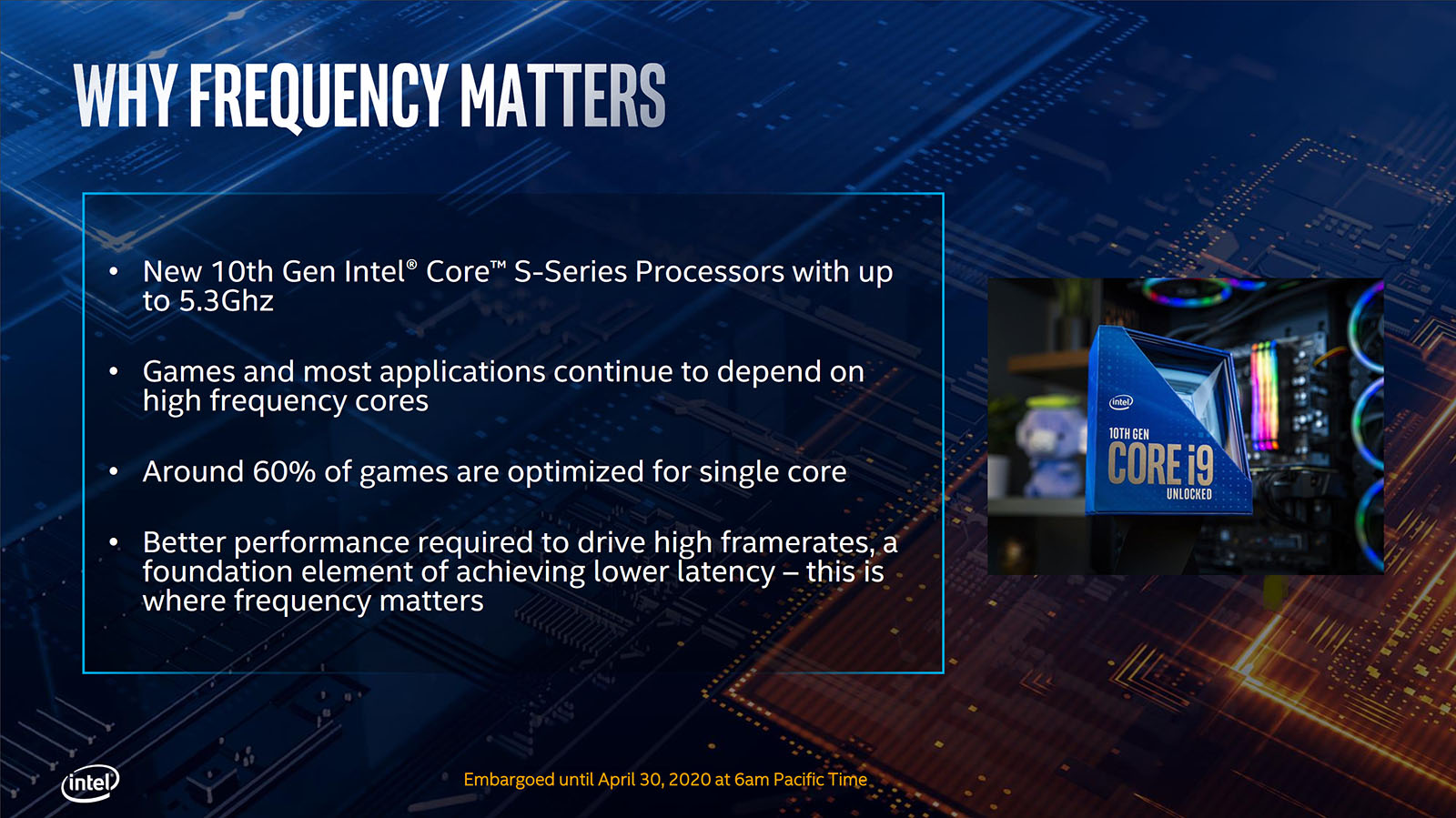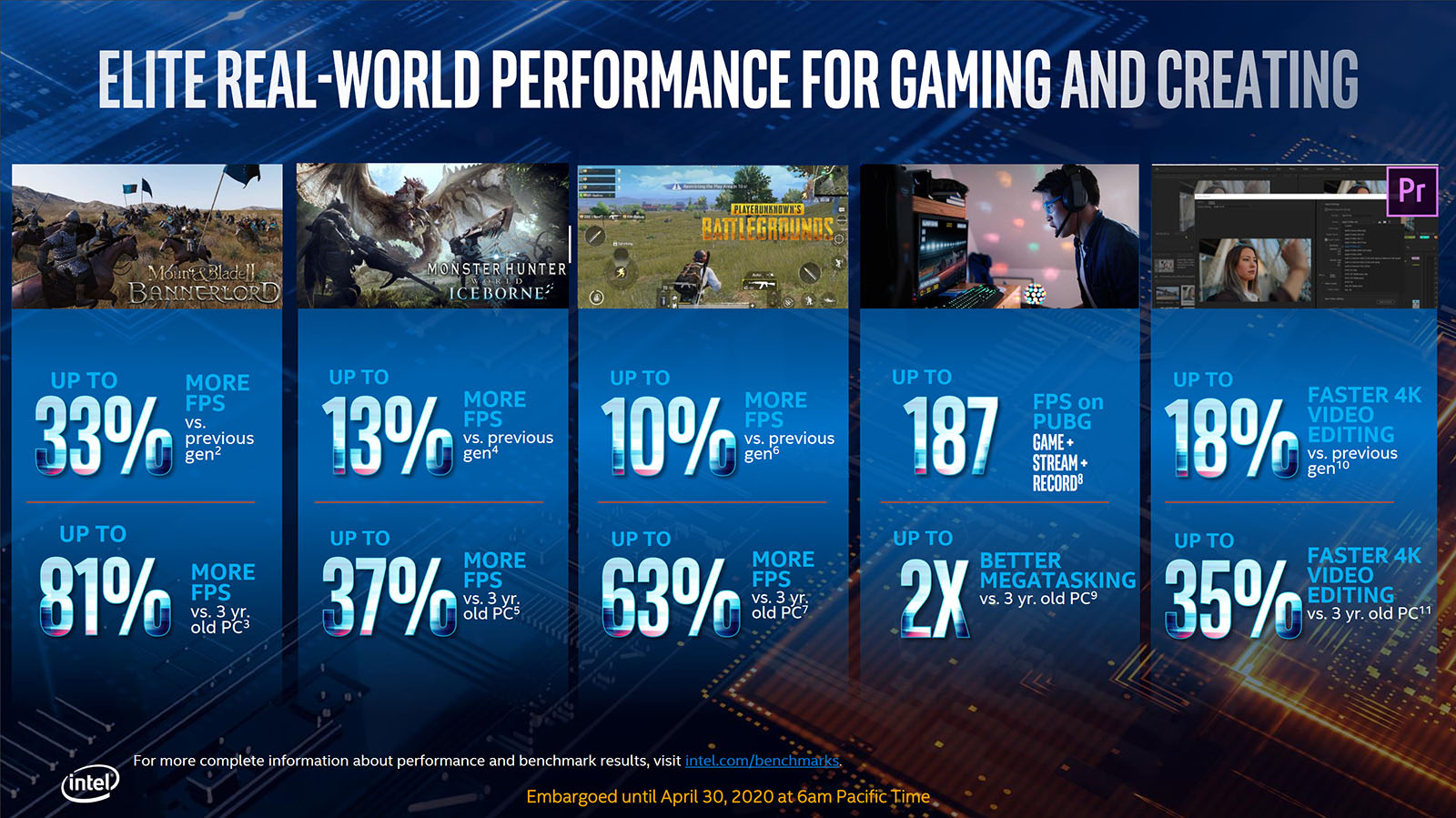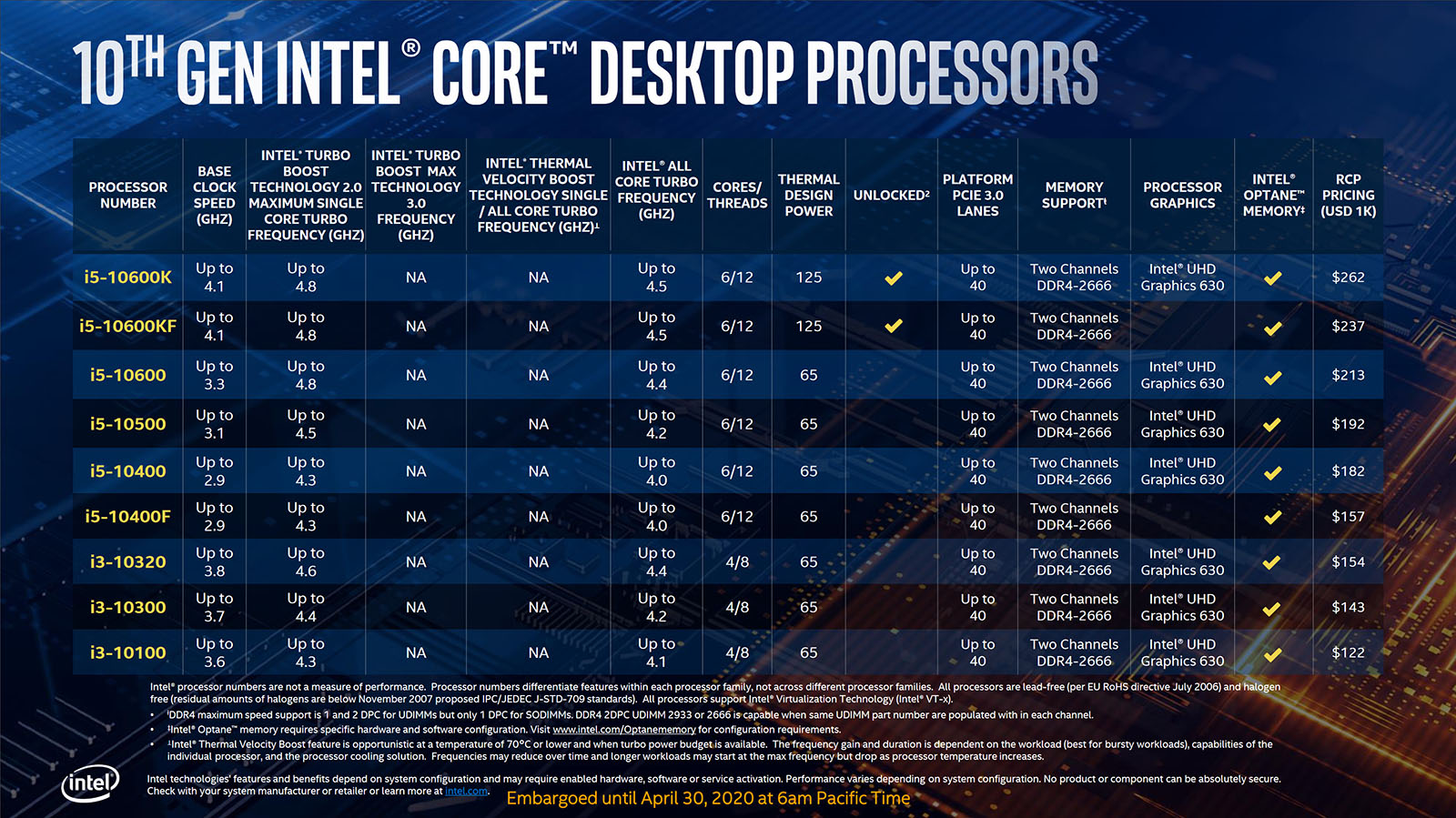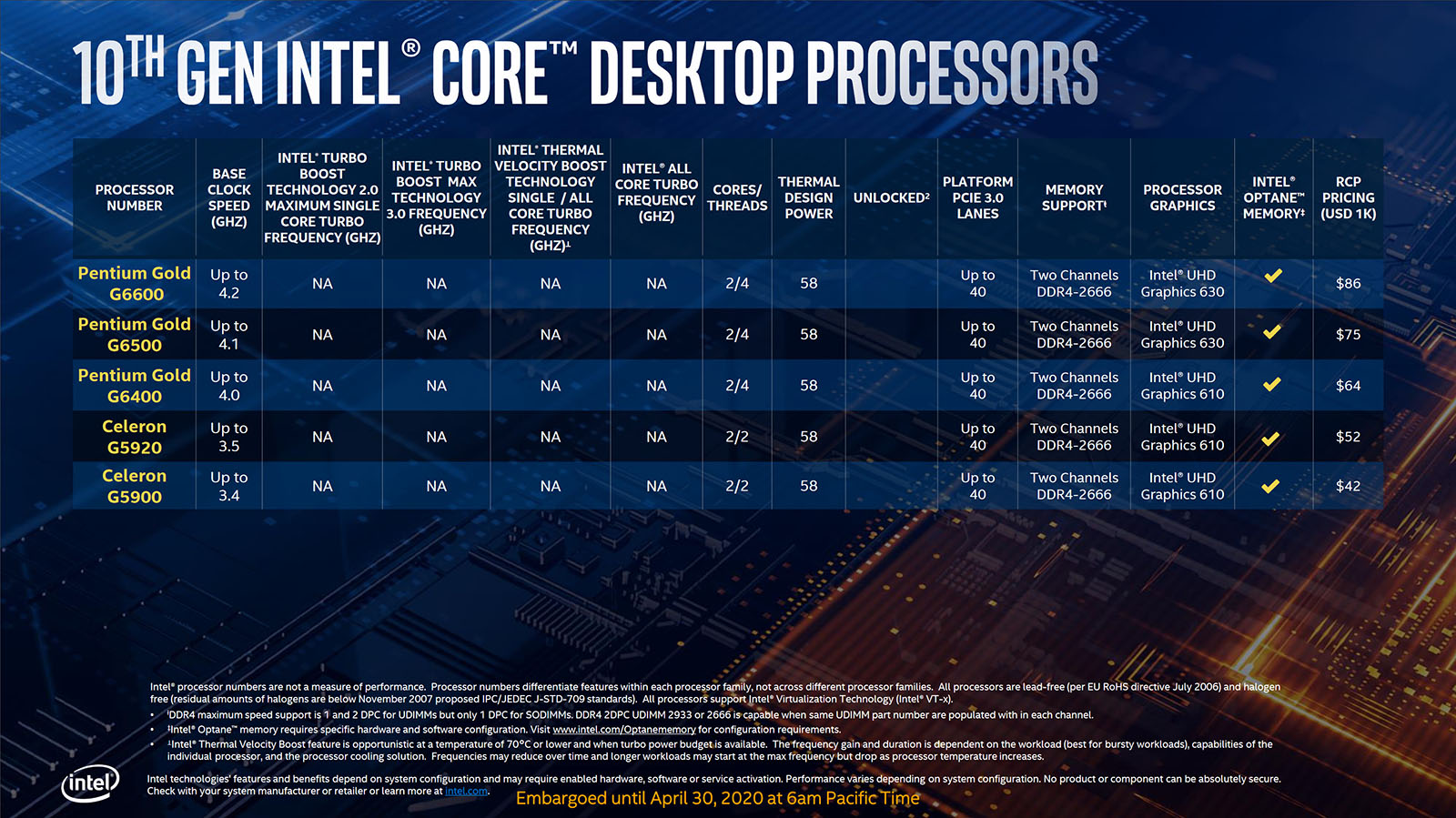Intel today announced its 10-series desktop CPUs, which it’s calling “10th Gen,” and that includes the 10-core / 20-thread Intel i9-10900K. Intel confirmed several of the specs we’ve exclusively published in the past couple of HW News episodes, but we can now talk about it in a more official capacity. A bigger focus on thermals was one of the key points, but we were also interested to see expanded overclocking support as a heavily promised feature for the 10-series Intel CPUs. Intel’s press announcement left a lot to be desired from an informational standpoint and the company ended the call before getting through all of the press questions, but we still have information we can work through today. Unfortunately, the press call was not without its usual stuffing of marketing that bordered on territory of “probably literally made up,” but Intel later retracted those claims after questioning. More on that later.
We should start with this curiosity: The LGA1200 socket, we’re fairly certain, is designed around Gen4 PCIe inclusion. Specifically, we think that the next major Intel CPU might be socketable into Z490 and will support Gen4 to major devices (e.g. first PCIe device, maybe an M.2 device). We’ve deduced this from two things. One, when asked why there are 49 more pins, Intel says the following:
“[It is for] improved power delivery and support for future incremental I/O features.”
Two, when we jumped to the PCIe Gen4 conclusion (because there’s not much else that is I/O and can be incremented), we checked with motherboard manufacturers and had our theories confirmed. For people with pitchforks out about Z490 having a new socket, thus ruining compatibility with Z390, this may be the actual reason. Time will tell. Z490 is mostly unchanged, though. You won't see many differences in Z490 vs. Z390 block diagrams:
The Intel Core i7-10700K -- sometimes called the “i9-10700K” by Intel -- looks the most interesting because it’s basically a 9900K for what should become $400 retail. Remember that Intel’s listed prices are for 1,000 units, so that’s close to wholesale pricing. We have some shots of the new CPU delidded to go through, but let’s start with the most important information first, then we’ll talk about the deeper-down thermal changes and about some of our reservations with the marketing:
Here’s Intel’s official slide for the main desktop specs. The Intel Core i9-10900K, tragically named as it is, should not be confused with the existing 10900X HEDT part that’s also 10 cores. The 10900X runs on X299 and has more PCIe lanes and also was dead on arrival, so best to not confuse them. The 10900K is advertised at 3.7GHz base, single-core turbo to 5.1GHz, Turbo Boost 3.0 to 5.2GHz on at least Windows, if not others, and Intel TVB – or Thermal Velocity Boost – up to 5.3GHz and 4.9GHz all-core. Intel’s defined TDP often runs close to the turbo duration expired power, so 125W looks like our baseline after turbo expiry. The pricing is the same as the 9900K, so that’s an improvement of two cores at the same price and might buy Intel some time before its next node.
“Thermal Velocity Boost” is a simpler version of what you might find on a GPU with its own Boost functionality, or on AMD with Precision Boost 2—not the same as Precision Boost Overdrive—in that it’ll follow temperature of the CPU. TVB works by establishing a thermal threshold, which is 70C for these CPUs, and effectively increasing the CPU bin if operating below that threshold and simultaneously below the power limit. This won’t be a sustained frequency unless you’ve manually modified your power limits in BIOS and unless you’re running powerful cooling, obviously, but it’s the future for CPUs after GPUs set the stage. If you wanted an analog for TVB with power limits disabled, it’d basically be Precision Boost with limits disabled, also known as Precision Boost Overdrive.
An extra two cores at similar frequencies to the 9900K will present thermal challenges, so on Intel’s end, this is mostly mitigated by bringing the silicon height closer to the substrate. We already leaked this information when we received it from a system integrator, but now Intel has officially confirmed what we said earlier.
The silicon will be 300 microns shorter than previously, dropping from 800 microns to 500 microns (according to Intel), and the goal is to get the heat out of the silicon and into the IHS faster. The IHS will be thicker than previously, though, because Intel wants to retain cooler support for the socket and that also means maintaining a torque and force spec that the CPU can withstand without bending. Decreasing the IHS thickness while also decreasing silicon thickness is a recipe for bending a CPU under the 50 pounds that the official LGA115X spec calls for, so Intel is deploying a thicker IHS than before. What Intel calls “sTIM” is also still in use, or soldered thermal interface material, rather than thermal paste previously. Only the K-SKU CPUs have thinned dies, but we’re not sure yet if all CPUs are soldered. The die thinning approach to silicon is interesting and a fact that we presented a few weeks ago and have seen in person. It’s definitely thinner and the IHS has more copper.
One quick point of clarity here: We’re now certain that Intel meant 300 microns shorter for the die, or 0.3mm, because that’d make the most sense. What Intel actually said on the call was “micro-millimters,” which we checked in our call recording. We spent a lot of time on Google, but to the best of our abilities, it looks like a micromillimeter would be one millionth of a millimeter, or about 0.000001mm, and we’re pretty sure that Intel’s change is more than 300 of… those. We later confirmed with Intel that it is, in fact, 300 microns (or micrometers).
Overclocking & Power States
Intel has defined its PL1, PL2, and Tau for its new CPUs as follows (direct quote):
- For the unlocked 10th Gen Intel® Core™ i9-10900K desktop processor, Intel’s configuration recommendation are PL1 = 125, PL2 = 250 and Tau = 56 seconds.
- For the unlocked 10th Gen Intel® Core ™ i9-10700K [SIC] desktop processor, Intel’s configuration recommendation are PL1 = 125, PL2 = 229 and Tau = 56 seconds.
- For the unlocked 10th Gen Intel® Core™ i5-10600K desktop processor, Intel’s configuration recommendation are PL1 = 125, PL2 = 182 and Tau = 56 seconds.
If you were to ignore all of this and go for overclocking, though, Intel has made some potentially critical updates to its OC support on this platform. This is a community often neglected, so it’s an important play for a company that has found itself in an enthusiast underdog position for the first time in over a decade.
The 10 series will introduce a volt-frequency curve to XTU, and ASUS already has this adapted into its OC utilities. Our understanding is that this will be made available through multiple software packages. The V-F curve OC will not be available via BIOS.
The idea is that a given frequency can run at a given voltage, rather than just a fixed voltage across all cores or an adaptive voltage over which the user has no control (and which rarely works, thanks to motherboard manufacturer implementations). The volt-frequency curve could presumably be tuned for the CPU to run at a lower voltage while at a lower frequency, having implications for a better per-chip power profile at the lower-end of performance and a more aggressive tune at the higher-end. This is mostly useful since all CPUs – AMD or Intel – are going to be set to accommodate the worst bin or lowest common denominator. If you end up with a better chip, which is likely, you could at least tune the power profile. We’re not sure if this will be worth using yet since it’s kind of hit-or-miss on GPUs, but we’ll give it a shot and see how it goes at launch. The biggest upside we took away from this presentation was explicit acknowledgement of overclocking.
Another overclocking-centric promise was the addition of DMI and PCIe overclocking, which will be interesting from a standpoint of trying to maximize PCIe Gen3 while AMD runs one generation ahead. Gen4 hasn’t been all that useful for graphics yet, but for SSDs, it starts to matter.
Intel is also adding per-core hyperthreading toggles to its controls, which will be fun to work with for competitive or extreme overclocking. We’re looking forward to using some of these new features in the Intel motherboards, and our Pro OC contacts have told us that Z490 is one of the easiest platforms to overclock on yet.
Intel made a number of claims in its marketing slides to press that we’d like to point-out.
First, Intel claimed that, quote, “around 60% of games are optimized for single core.” We asked Intel in the press call to clarify this phrasing. Namely, we wanted to know from what year this approximation was calculated. Intel answered this by suggesting that we take the question “offline” and follow-up, then failed to follow-up for about 24 hours. If Intel is referring to all games made ever in all time, including Space War, which was made for the PDP-1 in 1962, then 60% is probably undershooting it a little bit.
Speaking to today, though, we can tell you from first-hand experience that we’ve seen more frametime consistency issues than ever on older 4-core platforms, and we’re starting to see clear benefit to 6 or 8 real cores on a given CPU. Even if those games still load one core heavily, it can be a bit misleading to suggest that those games would run better on a CPU of uncertain core count so long as the primary thread is sufficiently fast.
Intel later did follow-up and noted this:
“Slide 3 in the file shared yesterday had a version error. The correct information is reflected in Slide 3 of the PDF deck saved to this folder. The bullet that was removed, pertaining to the 60% of games are optimized for single core, was meant to be an internal guide only. We regret the error, and appreciate your understanding.”
So it’s complete bullshit, basically, and Intel thought they could get it through. Someone at Intel needs to pretend to be “the press” before the actual press calls happen, because then maybe they could catch these “mistakes” before they go to media to get caught publicly.
It’s also odd that Intel would try to push the single-core claim so hard, considering Intel has multi-core CPUs. It comes across as Intel feeling inferior in size to AMD’s core count, because they do have multi-core CPUs. We understand that they probably mean that it’s “optimized” for a heavier render thread or single thread use, but the reality is that a sufficiently fast thread isn’t always enough – you still need some additional threads available to back it up.
To be fair to Intel, AMD also fills its presentations with marketing BS, including that one time they pointed a thermal camera at a heatsink, which is (1) literally supposed to be hot, because if it isn’t, then it’s not a heatsink, and (2) reflective, so now you’re compounding thermography issues with an reflectivity and emissivity and likely showing room temperature in anything sufficiently shiny. It seems they’re taking turns with padding presentations with marketing BS.
Intel also made claims regarding relative performance between its new CPUs and older hardware, but we’re not sure what older hardware. Unfortunately, we don’t know what that hardware is. Marketing slides like this are normally pointless, but this one is an extra level of pointless because they’re comparing it to a, quote, “3 yr old PC.” Intel only put its end notes on the screen for a few seconds per slide, but we did get a screenshot. Intel here is comparing most commonly to its own Intel i7-7700K, which also happens to be what AMD is comparing against for its Ryzen 3 3100 and 3300X CPUs that are coming up. That looks to be the posturing point going forward.
Back to the spec briefly, it looks like this: Intel is keeping its $500ish price-point of the 9900K, but with a CPU that should be objectively better. That’s a good move and will likely keep Intel at the top in gaming and may help it against the 3900X in some all-core workloads, but we’ll need to test that. The extra threads on the 3900X might be enough to keep it in the lead in Blender, although we suspect it may be close.
The 10900KF kills the integrated graphics in exchange for a $16 reduction in base pricing, so that tells you what Intel values its IGP at for retail. The specs are the same other than this. The 10900 non-K and F-non-K (these names are terrible) are locked and reduced to 65W TDP, which we should note is likely 1-for-1-ish when boost limits expire, and the 10700K is the 9700K replacement -- but it now has hyperthreading again. That’s probably the most significant move in this entire product stack and is also the most promising, because it’s effectively a 9900K at $350 1KU pricing, so that should put it probably around $400 retail. This is the one that we think will be the most promising from Intel.
The i5 series runs the 10600K at 4.5GHz all-core and is 6C/12T, also unlocked, and in the range of $237 to $262 1KU, so probably $250 to $280 retail. As for the i3 line, the rumors came true and that is in fact an old i7 replacement. These are 4C/8T parts, which is actually crazy when considering how utterly pointless the i3 line became in the last 3 years, and they also show promise for testing.
There’s also a set of Pentium Gold CPUs and Celerons, which we’ll likely cover in the $75 to $90 segment. The G-6500 will likely be around $90 MSRP and is a 2C/4T part at 4.1GHz. More discussion on these as they come out.
Overall, Intel has made some moves that are actually very promising, but we need to see how the products test. The marketing is really bad, but AMD’s marketing is also filled with things like “jebaited,” thermal cameras pointed at heatsinks, and using Ashes of the Singularity’s CPU test on Radeon while using the GPU test on GTX, if anyone was in the press room at the RX 480 event in Macau. We criticize the marketing in hopes that one day it’ll assume its audience is smarter than the average intelligence of a caterpillar, but for now, it is what it is.
Intel needs to compete and, to its credit, it really looks like it’s trying by putting hyperthreading back on some of the lower end parts. The 10900KF will likely be the new leader in gaming tests and the i3 parts will be interesting competition for Ryzen 3. We’re skeptical, given Intel’s recent history, that any of its parts will be available in purchaseable quantities, but that’s something to report back on at launch.
The products look potentially promising. We hope that next time, the company can stick to actual specifications.
Editorial: Steve Burke
Video: Keegan Gallick
